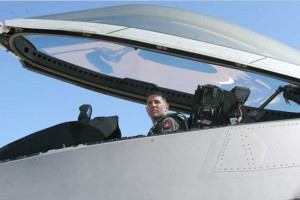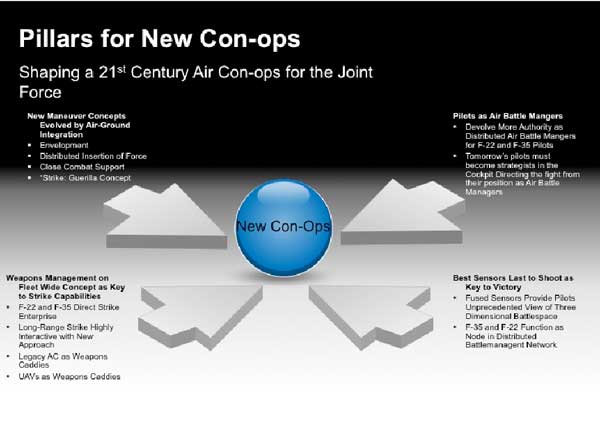“Going to War with the Air Force You Have”
By Michael W. Wynne
21st Secretary of the U.S. Air Force
10/29/2010 – One expects survival rates in that class to mimic the 8th Air Force in the Second World War, wherein the losses were so traumatic, they actually exceeded the Marine losses in the Pacific. The thought is here that if they are used in this manner, we will need a lot of them, but the good news is, the embedded technology can be minimized, and we have a good chance that our industry can produce great quantities. This would be very different if America owned the skies; and thus could exploit the domain at will.
So, as the recent activity that Israeli pilots and accompanying Heron UAV’s indicate, they have intelligence and targeting capability that can frustrate defenders. The Israeli pilots were not faced with an integrated air defense system, but did take the opportunity to extend the tactical envelope to combined vehicle operations, essentially extending the sensor suite of the fighters.
The concept of having your best sensors be the last to shoot will be a key to victory. The distributed battle space can be populated by nodes in the network able to provide strike or suppression assets and have the capability for forward deployed sensors to identify core fleeting or mobile targets. The ability for the best sensors to then be available over target areas to strike last to eliminate residual targets in the battle space is the then the key to victory.
The on-again off-again long-range recce strike platform has bomber capability for which technology programs should come together with a planned interim operating capability in mid 2020’s. Here is a case where DoD can put the concept of “good enough” to the test as requirements continue to arrive to get aboard this last bomber design for the next fifty years.
But if it does arrive; and can be seen to be unmanned in the recce role; and manned in the bomber role; the advantages of having an overwatch platform will be enhanced. Because of the size and by extending the sensor capability technology trend, the long-range strike and loiter asset will become the best sensor on the battlefield; and therefore take the last place in line to actually strike targets.
Such a concept will be a difficult one as it goes against many years of training to be a first strike asset. Such is the concept of knowledge as an asset in warfare must be embedded in our penetration planning.
Space assets will form a high level sensor and command grid above the battlespace presuming they survive the opening events of any future engagement. Space assets provide invaluable early intelligence; and can continue to be useful.
But clearly once there are alternative data paths available to the battle commander; the less valuable it will be to single out space assets for attack. Exercises like the recent “a day without space” highlight the need for the “‘node on the net” construct for communications. This can only happen with compatibility among space, air, maritime and land C4ISR assets. A CONOPs that looks for ‘first to fiber’ as a risk reducer should be a backbone of the communications and cyber plan.
A CONOPs that looks for ‘first to fiber’ as a risk reducer should be a backbone of the communications and cyber plan.
Given the “re-normed” knowledge-based battle management system shaped by the F-22 and F-35, we need to consider how to best use the legacy assets. Let’s consider bringing fourth generation to the forward edge of the battle also to act as functional “throw weight” in the advanced missile sphere. At first blush this would seem unnerving, but might be highly effective as an ‘over the shoulder’ launch–picked up and retargeted by the lead fifth generation aircraft. This would allow the stealth asset to remain “cloaked” while allowing the 4th gen shooter to exit safely after being exposed. It is expected that shortly that all sides will have developed ‘shooter track’ capability currently applied to ground missiles but adapted for the air fight.
We could also use legacy fighters as a protective curtain for the tanker operation and allowing the tanker to double as a router system for exfiltration of battlefield information.
The phrase every shooter a sensor and some sensors a shooter accurately frames the notion of leverage in the interoperability space. This in turn leads to a required weapons management plan for any and all available shooters that can reach the battlespace that must be imposed as a target rich environment can easily exhaust and thus waste the see deep capability. Spread the assets across the sky is imperative to employ effectively the weapons, both in terms of legacy aircraft and RPAs or UAVs.
Such a concept of operations was first exploited in an Alaskan exercise; when an undisciplined F-22 pilot expended all of his available ordnance and expected an exit plan, whereas the battle manager effectively advised him to become the air battle manager, and off-board his acquired targets to other friendly forces. In a similar vein, an F-15 pilot found himself directing the indirect fire from his vantage point to save an embattled ground commander guiding UAV and higher altitude release (e.g. bombers).
Such a CONOPs needs to be honed so as to impose ground commander command experience of battle management into aircraft commanders who are not trained as air battle managers, but are now being afforded the tools of the trade. And as mentioned, they become the best sensors and fusing mechanisms on the battlefield.
In time, fighter pilots should act in similar ways to ground commanders organizing the ingressing command, making sure that the central air operations center is distributing targets to other shooters, but protecting his area of operation; keeping his fire teams progressing to the objectives while saving the best shooters for the end game mission; then as well organizing the withdrawal, hopefully with covering fire from other now ingressing command cells.

As ground troops are introduced into the fight, the air battle manager now effectively becomes the area battle manager, and this operation can be transitioned to a legacy aircraft and heavied-up (e.g. full external weapons load) F-35s essentially to maintain the air dominant position attained. In such a manner, the ground units can be forced into a protected zone, entering the fight to truly secure deep and hardened targets.
The Marine Corps concept of operations comes closest to the shift in operational focus, although they will transition to provide high cover to the F-18 and tactical UAV fleet to maintain area control. Here we see maneuver teams dropped sometimes behind the enemy, sometimes beside them, maximizing survival at entry, with specific mission links to protect the air assets from buried emplacements and then suppress enemy maneuvers. It is highly likely that coordinated close air support facilitated by the new air operations approach can curtail enemy maneuvers.
America has enjoyed the real benefit of bypassing the tediously heavily defended enemy. It has become almost a planning dictum that within 72 hours, we are into the logistics of resupply. Here we should postulate and relearn the more difficult strategy and tactics of maneuver warfare and resupply on the move that we have accomplished to some degree in the present engagements: attacking in maneuver and defending in place, essentially maximizing our capability; as well the Clausewitzian multipliers that have been known throughout the age of warfare.
One can extrapolate such an approach to classic over the beach operations. Once a breach has been accomplished, the game then truly is logistics and resupply. But as at Normandy, the enemy gets a vote, and there can be progress mixed with problems.
With concepts like sea basing, vertical logistics and GPS on pallets, the air arm is well versed in picking up this mission and able to lead to envelopment and leap frog capabilities which complicate the strategies of an enemy expecting to defeat a hierarchically organized enemy. The new distributed air operations allow U.S. forces to conduct distributed assaults, distributed defenses and to operate almost like a “regular” guerilla force.
As a fighting force, we have picked well where to operate these past 40 years; two generations of warriors have never been exposed to an air dominance shortfall. In three generations ground commanders have not had to cope with strafing and enemy interdiction from the air of their supply lines.
With the advent of advanced integrated air defense, coupled with deep, hardened and highly mobile targets, we will have to think and train differently. We cannot assume air dominance; indeed we can expect that denial capabilities might well grow faster than traditional air superiority capabilities.
Such an expectation coupled with a hard-nosed realistic view of where we are and where the trends are taking us should encourage the complete re-look at the technologies are becoming available with the F-22/F-35 and the fully integrated tactics they involve. Training to be a totally different force will be an imperative.
Tomorrows pilots must become strategists in the cockpit, directing the fight from their position as air battle managers, as if they are Civil War generals—observing and aggressively acting only when they become the last line for success or failure.
To realize such capability will require both training and discipline. Our Air Force command and staff and Air War College needs to better integrate the air operations center together with the deep sensor-strike capability to build the capability America will need to continue to have the air dominance mission fulfilled in the coming days of declining numbers of air assets.
A new CONOPs leveraging the new aircraft and able to incorporate legacy platforms and to shape new investments enhancing the joint effect is crucial to success. Declining numbers, coupled with a refusal to recognize the “re-norming challenge,” will lead to a needless loss of capability.
But we need as well to invest in the future, not just modernize the past, and step back and consider which tactics techniques and procedures have current technology trends been guiding the future fight; we need to also consider the training needed to perfect our capabilities. We need to retool and to rethink, and it must start in our imagination and not assume that historical success will be replicated in the future without serious effort.
A new CONOPs leveraging the new aircraft and able to incorporate legacy platforms and to shape new investments enhancing the joint effect is crucial to success. Declining numbers, coupled with a refusal to recognize the “re-norming challenge,” will lead to a needless loss of capability. But we need as well to invest in the future, not just modernize the past, and step back and consider which tactics techniques and procedures have current technology trends been guiding the future fight; we need to also consider the training needed to perfect our capabilities. We need to retool and to rethink, and it must start in our imagination and not assume that historical success will be replicated in the future without serious effort.

This complete 14 page exclusive report can be downloaded as a pdf file [3.0MB].



